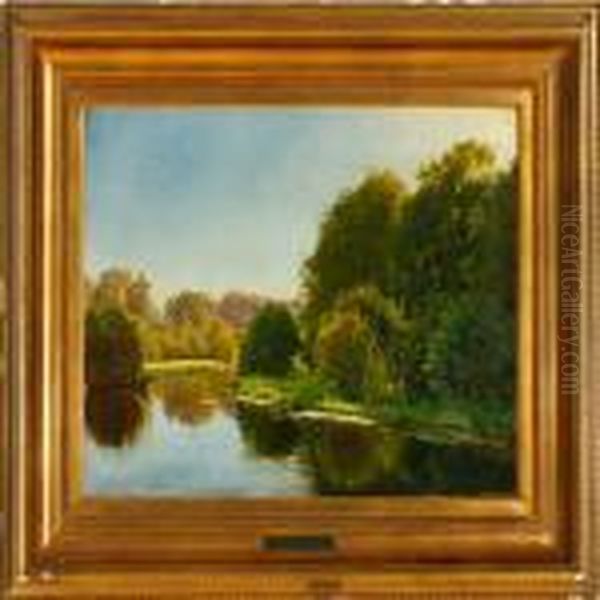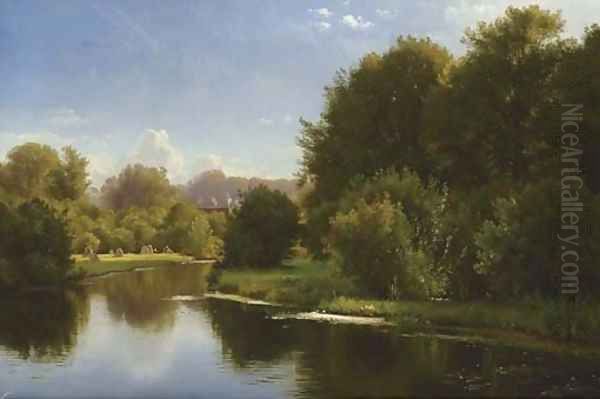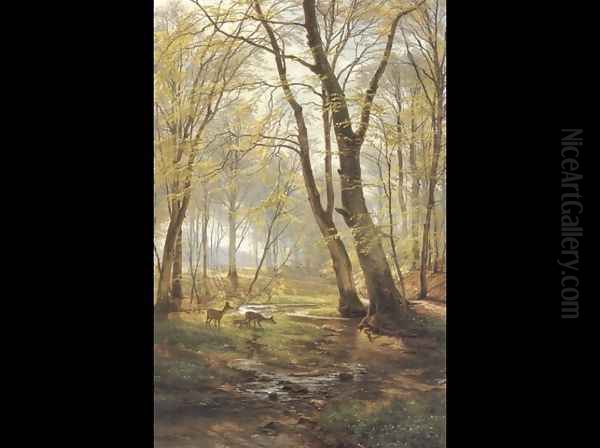Carl Frederik Aagaard stands as a significant figure in the annals of Danish art, a painter whose canvases captured the ethereal beauty of the natural world with a sensitivity and skill that resonated with his contemporaries and continues to charm art lovers today. Born in Odense, Denmark, on January 29, 1833, and passing away in Copenhagen on November 2, 1895, Aagaard's life and career spanned a period of transition in European art, bridging the late Romantic sensibilities of the Danish Golden Age with emerging Realist trends. He was not only a prolific landscape painter but also a respected decorative artist, leaving an indelible mark on both the galleries and public spaces of Denmark.
Early Life and Artistic Awakening
Carl Frederik Peder Aagaard's journey into the world of art began in his youth. While detailed accounts of his earliest inspirations are scarce, it is known that he initially trained as a craftsman, working with his elder brother, Johan Peter Aagaard, who was a skilled wood and glass engraver. This early exposure to decorative arts and craftsmanship likely instilled in him a meticulous attention to detail and an appreciation for skilled execution, qualities that would later define his paintings.
His formal artistic education commenced at the prestigious Royal Danish Academy of Fine Arts in Copenhagen. The Academy, founded in 1754, had been the crucible of the Danish Golden Age of Painting (roughly 1800-1850), a period that saw artists like Christoffer Wilhelm Eckersberg, Christen Købke, Johan Thomas Lundbye, Martinus Rørbye, and Wilhelm Marstrand establish a distinctly Danish school of art, characterized by its keen observation of local scenery, everyday life, and a subtle, often melancholic, luminosity. Though Aagaard entered the Academy as this golden period was waning, its influence was still palpable.
Formative Influences: The Royal Danish Academy and P.C. Skovgaard

At the Academy, Aagaard came under the tutelage of several notable figures, but perhaps the most significant influence on his development as a landscape painter was Peter Kristian Skovgaard (often P.C. Skovgaard). Skovgaard was a towering figure in Danish National Romantic landscape painting, renowned for his majestic depictions of Danish forests, particularly beech trees, and his ability to imbue these scenes with a sense of national identity and profound natural grandeur. Skovgaard's emphasis on direct observation of nature, combined with a romantic sensibility, deeply impacted Aagaard.
Under Skovgaard's guidance, Aagaard honed his skills in capturing the nuances of the Danish landscape. He learned to observe the play of light and shadow, the subtle shifts in color through the seasons, and the unique atmospheric qualities of his homeland. While Eckersberg had championed a more objective, almost scientific approach to realism earlier in the century, Skovgaard and his followers, including Aagaard, leaned towards a more poetic and emotionally resonant interpretation of nature.
Beyond Skovgaard, Aagaard also collaborated with the decorative painter Georg Christian Hilker. Hilker was known for his Pompeian-style decorations and worked on numerous significant public and private commissions. This collaboration allowed Aagaard to develop his talents in decorative art, a field in which he would also achieve considerable success.
The Danish Landscape: Aagaard's Enduring Muse
The Danish landscape, in all its varied beauty, remained Aagaard's primary and most beloved subject throughout his career. He possessed an innate ability to translate the quiet charm of his native scenery onto canvas, from the dense, sun-dappled forests and serene lakes to the rugged coastlines and expansive skies. His works often evoke a sense of tranquility and a deep reverence for nature.
Aagaard was particularly adept at capturing the specific moods and atmospheres of different times of day and seasons. His forest scenes, for instance, often feature intricate renderings of foliage, with light filtering through the canopy to create a mosaic of brightness and shade on the forest floor. Works like "Summer Day at a Forest Lake" (or "Summer at the Forest Lake") exemplify this, showcasing his skill in rendering water reflections, the lushness of summer greenery, and an overall feeling of peaceful immersion in nature.
His snow scenes, such as the aptly titled "Danish Snow Scene," demonstrate a different facet of his talent. He masterfully depicted the crisp air, the soft blanket of snow transforming the familiar landscape, and the subtle cool light of a winter's day. These paintings are not merely topographical records but are imbued with a poetic quality, reflecting the quietude and stark beauty of Denmark under snow.
Travels Abroad: Expanding Artistic Horizons

Like many artists of his time, Aagaard undertook journeys abroad to broaden his artistic perspectives and find new subjects. In the 1860s and 1870s, he made several trips, notably to Switzerland and Italy. These travels exposed him to different types of landscapes, light conditions, and artistic traditions, which subtly enriched his work.
His Italian sojourns, in particular, seem to have had a noticeable impact. The brilliant Mediterranean light and the picturesque scenery of Italy offered a contrast to the more subdued tones of his native Denmark. Works inspired by these travels, such as "Mediterranean Rose Garden," showcase a brighter palette and a different kind of atmospheric warmth. He painted coastal views, ancient ruins, and lush gardens, capturing the distinct character of the Italian landscape while retaining his signature attention to detail and compositional harmony.
These trips were not uncommon for Danish artists. Figures like Constantin Hansen and Wilhelm Marstrand had spent considerable time in Italy, and their experiences there had profoundly shaped their art. While Aagaard remained fundamentally a painter of the Danish landscape, his experiences abroad added a cosmopolitan dimension to his oeuvre and allowed him to explore a wider range of natural beauty.
A Master of Light and Atmosphere
A hallmark of Carl Frederik Aagaard's style is his masterful handling of light and atmosphere. He understood that light was not merely illumination but a key expressive element that could define form, create mood, and evoke emotion. Whether depicting the soft, diffused light of a Danish summer evening, the crisp clarity of a winter morning, or the golden glow of an Italian sunset, Aagaard's sensitivity to light was paramount.
His compositions are typically well-balanced, often leading the viewer's eye into the scene through carefully placed elements like winding paths, receding shorelines, or a break in the trees. He paid close attention to the textures of nature – the roughness of bark, the softness of moss, the transparency of water, the fluffiness of clouds – rendering them with a verisimilitude that invites close inspection.

While his work is generally characterized by a realistic approach, it is a realism tempered with a romantic or poetic sensibility. His landscapes are rarely stark or overly dramatic; instead, they possess a gentle, lyrical quality. This aligns him with the broader National Romantic movement in Danish art, which sought to find the sublime and the beautiful in the specific character of the Danish land and its natural phenomena. Artists like Vilhelm Kyhn, a contemporary landscape painter, also explored similar themes, though often with a different stylistic emphasis.
Decorative Works: Art Beyond the Canvas
Alongside his prolific output of easel paintings, Carl Frederik Aagaard was also a highly regarded decorative artist. This aspect of his career is sometimes overlooked but was significant during his lifetime. His collaboration with Georg Hilker on projects such as the decorative paintings for the festival hall of the Royal Veterinary and Agricultural University in Copenhagen (Landbohøjskolen) was a notable achievement. These large-scale works required a different set of skills than easel painting, involving an understanding of architectural space and the ability to create designs that harmonized with their surroundings.
He also contributed decorative elements to other important buildings, including the Dagmar Theatre and the Royal Danish Theatre in Copenhagen. Perhaps one of his most prestigious commissions in this field was for Roskilde Cathedral, the traditional burial site of Danish monarchs. Creating decorative paintings for such a historically and culturally significant edifice speaks to the high esteem in
which his decorative talents were held. This versatility, moving between the intimate scale of landscape painting and the grander scope of architectural decoration, was a testament to his broad artistic capabilities.
Notable Works and Their Characteristics
Several paintings stand out in Aagaard's oeuvre, exemplifying his style and thematic concerns.
"Men and Boys Fishing in a Boat" captures a serene moment of everyday life integrated into a tranquil waterscape, showcasing his ability to combine genre elements with landscape.
"Summer Day at a Forest Lake" (or "Skovsø, Sommerdag") is a quintessential Aagaard piece, radiating warmth and the lushness of a Danish summer, with meticulous detail in the foliage and reflections.
"Landscape with a Stream," held by the Metropolitan Museum of Art in New York, is an example of his work reaching international collections, likely depicting a Danish scene with a meandering stream, a common motif that allowed for exploration of light on water and verdant banks.
"Hilly landscape with old oaks" (1859) would be an earlier work, perhaps showing the stronger influence of Skovgaard in its depiction of venerable trees and a rolling Danish terrain.
The "Maid in Visby Forest Park" is an interesting example that includes a more prominent figure, suggesting his occasional foray into compositions where human presence plays a more central, albeit still harmonious, role within the landscape.
His depictions of specific locations, such as views from Møns Klint or the forests of Zealand, were popular. He often returned to similar motifs, exploring them under different light conditions or from slightly varied perspectives, demonstrating a deep and sustained engagement with his chosen subjects.
Recognition and Professional Standing
Carl Frederik Aagaard achieved considerable recognition during his lifetime. He began exhibiting his works regularly at the prestigious Charlottenborg Spring Exhibition in Copenhagen from 1857. That same year, he was awarded the Neuhausen Prize, an important Danish art award that helped to establish his reputation early in his career. His participation in the Danish National Landscape Painting Exhibition in 1863 further solidified his standing as a leading landscape painter.
His contributions to Danish art were formally acknowledged in 1874 when he was elected a member of the Royal Danish Academy of Fine Arts, the very institution where he had received his training. This was a significant honor, indicating the respect he commanded among his peers. Further accolades followed: in 1879, he was made a Knight of the Order of Dannebrog, a Danish order of chivalry, recognizing his service and distinction in the field of art. His works were sought after by private collectors and public institutions, ensuring his presence in the cultural landscape of Denmark.
Aagaard in the Context of Danish and European Art
Aagaard's career unfolded during a dynamic period in art history. The Danish Golden Age, with its luminaries like Eckersberg, Købke, Lundbye, and Rørbye, had established a strong tradition of landscape and genre painting. Aagaard inherited this legacy, particularly the emphasis on direct observation and the love for Danish scenery. However, he was also a man of his own time. While the Golden Age painters often imbued their work with a Biedermeier sense of order and quietude, Aagaard's generation, influenced by National Romanticism, sometimes sought a more overtly poetic or emotionally charged depiction of nature, as seen in the work of his mentor Skovgaard, or in the dramatic coastal scenes of Anton Melbye.
Internationally, landscape painting was undergoing significant transformations. In France, the Barbizon School (with artists like Jean-Baptiste-Camille Corot and Théodore Rousseau) was emphasizing a more direct and unidealized approach to nature, paving the way for Impressionism. While Aagaard's style remained more rooted in the detailed realism of the Danish tradition, the broader European interest in landscape as a primary subject certainly provided a supportive context for his work. He was less radical than the Impressionists, but his dedication to capturing the fleeting effects of light and atmosphere shows a shared concern.
Later Danish artists, such as the Skagen Painters (P.S. Krøyer, Michael Ancher, Anna Ancher) who rose to prominence towards the end of Aagaard's life, would take Danish art in new directions, often characterized by a brighter palette and a focus on the unique light and life of Skagen in northern Jutland. Figures like Theodor Philipsen were also instrumental in introducing Impressionistic tendencies to Denmark. Aagaard, therefore, can be seen as a key figure in the continuation and evolution of the Danish landscape tradition in the latter half of the 19th century, before these newer movements took full hold. Other contemporaries like Christen Dalsgaard focused more on genre scenes, while Carl Bloch excelled in historical and religious painting, highlighting the diversity of Danish art during this period.
Anecdotes and Personal Life
While Carl Frederik Aagaard's professional achievements are well-documented, details about his personal life and specific anecdotes are less widely recorded in accessible sources. He appears to have been a dedicated and hardworking artist, committed to his craft. His travels, his teaching (he also took on private students), and his involvement in the Academy suggest a life deeply immersed in the art world. The lack of colorful or dramatic personal stories often means that the artist's legacy is primarily understood through the body of work they leave behind, and in Aagaard's case, his paintings speak eloquently of his character: a lover of nature, a meticulous observer, and a skilled craftsman with a poetic soul. His brother, Johan Peter Aagaard, also achieved note as a xylographer and publisher, indicating an artistic inclination within the family.
The Enduring Legacy of Carl Frederik Aagaard
Carl Frederik Aagaard passed away on November 2, 1895, in Copenhagen. He left behind a substantial body of work that continues to be appreciated for its technical skill, its faithful yet poetic rendering of nature, and its quintessential Danishness. His paintings are held in numerous Danish museums, including the Statens Museum for Kunst (National Gallery of Denmark), ARoS Aarhus Art Museum, and many regional collections, as well as in international institutions like the Metropolitan Museum of Art.
His legacy lies in his contribution to the rich tradition of Danish landscape painting. He successfully carried forward the observational rigour of the Golden Age while infusing his work with the romantic sensibility prevalent in his time. He was a bridge figure, upholding established traditions while also being open to the influences of his travels and the evolving artistic climate. His decorative works also contributed significantly to the aesthetic environment of important public buildings, showcasing his versatility.
For art historians and enthusiasts of 19th-century European art, Aagaard's work offers a window into the Danish soul and its deep connection to the land. His paintings are more than just picturesque views; they are heartfelt expressions of an artist's lifelong engagement with the beauty and tranquility of the natural world. In an era increasingly dominated by industrialization and urban growth, Aagaard’s landscapes offered, and continue to offer, a vision of nature as a source of solace, beauty, and enduring inspiration. His dedication to capturing the subtle nuances of the Danish environment ensures his place as one of Denmark's cherished landscape artists.